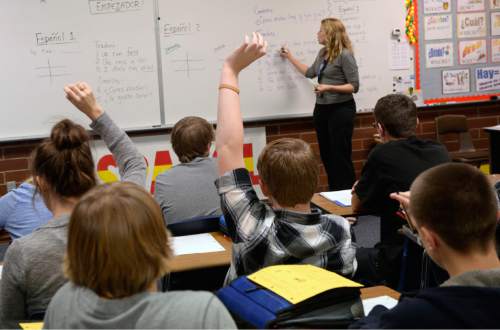This is an archived article that was published on sltrib.com in 2016, and information in the article may be outdated. It is provided only for personal research purposes and may not be reprinted.
The Utah Board of Education wants more flexibility in new federal regulations for school accountability.
The panel over Utah's 1,080 schools on Tuesday released a letter it sent to the U.S. Department of Education, arguing for greater say in how the state measures its progress and reports data to federal officials under the Every Student Succeeds Act (ESSA).
And a requirement that states report how many high school graduates are enrolled in college the following year may skew the picture of school success in Utah, where many students serve Mormon missions right after their senior year.
Men can leave at 18, and women at 19, to join The Church of Jesus Christ of Latter-day Saints' global proselytizing force of over 74,000.
"That's something in the regs that doesn't necessarily capture the quality of education in the state," said Deputy Superintendent Rich Nye.
On other measures, the board wrote that the draft rules are more stringent than the law itself.
The ESSA grants states more leeway in setting their own goals than did the previous No Child Left Behind Act, allowing them to hash out their own benchmarks in addition to federal criteria. But board members take issue with "the level of detail that [the feds] get into" in the new draft of guidelines supporting the law, said board Chairman David Crandall.
Among the elected committee's concerns: ESSA would penalize a school if more than 5 percent of its students are opted out of standardized testing.
Board members point out that opting out is permitted under state and federal law, but that it can bring penalties under the new rules if enough families choose not to have their children participate.
"At some point, that needs to be reconciled," Nye said.
Opt-out rates at Utah school districts in recent years generally have hovered around 1 to 3 percent for the state's end-of-year SAGE test, given to students in grades three through eight. But the level jumped to 11.5 percent in Provo School District in 2015, and 7 percent in the Piute County schools.
It also is higher among charters. At American Preparatory Academy's campuses, for example, 1 in 3 students sat out the test. Draper's Gateway Academy had 30 percent opt out.
The relatively high rates are not unique to Utah. In New York last year, for example, parents opted 20 percent of students out of yearly statewide testing.
The board also asked the U.S. Department of Education to remove dollar amounts dictating how much Utah must spend to help struggling schools. And data from prior years, not just recent numbers, the board argued, should be used in determining which schools need the state's help.
These changes would allow states to determine the best way to intervene, the board wrote.
"We'd like to determine what our own accountability system is without the feds telling us what we'd have to include," said Nye. "It's an example of federal overreach."
The letter, signed by Crandall and state Superintendent Sydnee Dickson, was submitted during a public comment period on the proposed federal guidelines. It identifies a number of other perceived problems, including an "unworkable" timeline with new metrics to be in place for the 2017-2018 school year.
The new federal measure was signed into law in December after Congress allowed the No Child Left Behind Act to expire. The former law forced corrective policies on schools each year if they didn't meet changing benchmarks.
The new regulations are set to go into effect next year.
Twitter: @anniebknox





